The Trends of the Energy Intensity and CO2 Emissions Related to Final Energy Consumption in Ecuador: Scenarios of National and Worldwide Strategies
Abstract
1. Introduction
2. Materials and Methods
2.1. Scenarios Considered for Analysis
2.2. Modeling and Simulation
2.3. Model Validation
3. Results
4. Discussion
5. Conclusions
Author Contributions
Funding
Conflicts of Interest
References
- CO2.earth. Earth’s CO2 Home Page, September 2019. Available online: https://www.co2.earth/earths-co2-main-page (accessed on 30 October 2019).
- UN Environment. United Nations Environment Programme. Available online: https://www.unenvironment.org/explore-topics/climate-change/about-climate-change (accessed on 29 October 2019).
- Querol, X.; Baldasano, J.; Boldo, E.; Borge, R.; Casanova, J.; Castro, T.; Cristóbal, Á.; Lanzani, G.; Lumbreras, J.; Lutz, M.; et al. Air Quality in Cities. A Global Challenge; Fundació Naturgy: Barcelona, Spain, 2018. [Google Scholar]
- Fogarty, D. The Straits Times, 6 December 2018. Available online: https://www.straitstimes.com/world/study-global-co2-emissions-to-hit-record-in-2018 (accessed on 30 October 2019).
- IPCC. Climate Change 2014: Impacts, Adaptation, and Vulnerability; Cambridge University Press: New York, NY, USA, 2014. [Google Scholar]
- Lazaroiu, G.; Ciupageanu, D.A. Multi-criteria decision mking in sustainable renewable energy systems. In Proceedings of the 19th International Multidisciplinary Scientific GeoConference, Sofia, Bulgaria, 29 June 2019; Volume 4, pp. 332–352. [Google Scholar]
- Ciupageanu, A.; Lazaroiu, G.; Barelli, L. Wind energy integration: Variability analysis and power system impact assessment. Energy 2019, 185, 1183–1196. [Google Scholar] [CrossRef]
- Ciupageanu, D.-A.; Lazaroiu, G.; Mihai, T. Carbon dioxide emissions reduction by renewable energy employment in Romania. In Proceedings of the IEEE International Conference on Electromechanical and Power Systems, Iasi, Romania, 12 October 2017; Volume 11, pp. 281–285. [Google Scholar]
- Capellán-Péreza, I.; de Castro, C.; González, L.J.M. Dynamic Energy Return on Energy Investment (EROI) and material requirements in scenarios of global transition to renewable energies. Energy Strategy Rev. 2019, 26, 1–26. [Google Scholar] [CrossRef]
- Herrerias, M. World energy intensity convergence revisited: A weighted distribution dynamics approach. Energy Policy 2012, 49, 383–399. [Google Scholar] [CrossRef]
- The Global Goals for Sustainable Development. The 17 Goals. Available online: https://www.globalgoals.org/ (accessed on 30 September 2019).
- Wang, C. Changing energy intensity of economies in the world and its decomposition. Energy Econ. 2013, 40, 637–644. [Google Scholar] [CrossRef]
- Intergovernmental Panel on Climate Change. Climate Change 2014: Synthesis Report; IPCC: Geneva, Switzerland, 2015. [Google Scholar]
- Yeh, J.-C.; Liao, C.-H. Impact of population and economic growth on carbon emissions in Taiwan using an analytic tool STIRPAT. Sustain. Environ. Res. 2017, 27, 41–48. [Google Scholar] [CrossRef]
- Lin, B.; Tan, R. Sustainable development of China’s energy intensive industries: From the aspect of carbon dioxide emissions reduction. Renew. Sustain. Energy Rev. 2017, 77, 386–394. [Google Scholar] [CrossRef]
- Mirzaei, M.; Bekri, M. Energy consumption and CO2 emissions in Iran, 2025. Environ. Res. 2017, 154, 345–351. [Google Scholar] [CrossRef]
- Lin, B.; Omoju, O.E.; Okonkwo, J.U. Impact of industrialisation on CO2 emissions in Nigeria. Renew. Sustain. Energy Rev. 2015, 52, 1228–1239. [Google Scholar] [CrossRef]
- Saidi, K.; Hammami, S. The impact of CO2 emissions and economic growth on energy consumption in 58 countries. Energy Rep. 2015, 1, 62–70. [Google Scholar] [CrossRef]
- Martínez-Zarzoso, I.; Bengochea-Morancho, A. Pooled mean group estimation of an environmental Kuznets curve for CO2. Econ. Lett. 2004, 82, 121–126. [Google Scholar] [CrossRef]
- Apergis, N.; Payne, J.E. CO2 emissions, energy usage, and output in Central America. Energy Policy 2009, 37, 3282–3286. [Google Scholar] [CrossRef]
- Lean, H.; Smyth, R. CO2 emissions, electricity consumption and output in ASEAN. Appl. Energy 2010, 87, 1858–1864. [Google Scholar] [CrossRef]
- Hossain, M.S. Panel estimation for CO2 emissions, energy consumption, economic growth, trade openness and urbanization of newly industrialized countries. Energy Policy 2011, 39, 6991–6999. [Google Scholar] [CrossRef]
- Pao, H.-T.; Tsai, C.-M. CO2 emissions, energy consumption and economic growth in BRIC countries. Energy Policy 2010, 38, 7850–7860. [Google Scholar] [CrossRef]
- Arroyo, F.; Miguel, L. Analysis of energy demand scenarios in Ecuador: National government policy perspectives and global trend to reduce CO2 emissions. Int. J. Energy Econ. Policy 2019, 9, 364–374. [Google Scholar]
- Li, K.; Lin, B. Impacts of urbanization and industrialization on energy consumption/CO2 emissions: Does the level of development matter? Renew. Sustain. Energy Rev. 2015, 52, 1107–1122. [Google Scholar] [CrossRef]
- Tang, V.; Vijay, S. (Massachusetts Institute of Technology, Cambridge, Massachusetts). Personal communication, 2001.
- Metcalf, G.E. An Empirical Analysis of Energy Intensity and Its Determinants at the State Level. Energy J. 2008, 29, 1–26. [Google Scholar] [CrossRef]
- OECD. Energy, OECD Growth Studies Energy; OECD: Paris, France, 2011. [Google Scholar]
- International Energy Agency. Market Report Series: Energy Efficiency 2017; International Energy Agency: París, France, 2017. [Google Scholar]
- Atalla, T.; Bean, P. Determinants of energy productivity in 39 countries: An empirical investigation. Energy Econ. 2017, 62, 217–229. [Google Scholar] [CrossRef]
- Carpio, C.V. Analysis of Energy Intensity in the End-Use Sectors of the Ecuadorian Economy. Master’s Thesis, University of Technology, Sydney, Australia, 2015. [Google Scholar]
- Huang, J.; Du, D.; Tao, Q. An analysis of technological factors and energy intensity in China. Energy Policy 2017, 109, 1–9. [Google Scholar] [CrossRef]
- Firlej, K. Energy intensity of GDP in the light of energy policy objectives in Poland until 2030. In Proceedings of the International Conference Hradec Economic Days 2012—Economic Development and Management of Regions, Hradec Kralove, The Czech Republic, 31 January–1 February 2012; pp. 1–8. [Google Scholar]
- Eder, L.; Provornaya, I. Analysis of energy intensity trend as a tool for long-term forecasting of energy consumption. Energy Effic. 2018, 11, 1971–1997. [Google Scholar] [CrossRef]
- Gielen, D.; Boshell, F.; Saygin, D.; Bazilian, D.M. N. Wagner and R. Gorini, The role of renewable energy in the global energy transformation. Energy Strategy Rev. 2019, 24, 38–50. [Google Scholar] [CrossRef]
- Robledo, J.C.; Olivares, W. Relationship between CO2 emissions, energy consumption and GDP: The case of CIVETS. Semest. Económico 2013, 16, 45–66. [Google Scholar]
- Saboori, B.; Sulaiman, J. CO2 emissions, energy consumption and economic growth in Association of Southeast Asian Nations (ASEAN) countries: A cointegration approach. Energy 2013, 55, 813–822. [Google Scholar] [CrossRef]
- Contreras, G.; Platania, F. Economic and policy uncertainty in climate change mitigation: The London Smart City case scenario. Technol. Forecast. Soc. Chang. 2019, 142, 384–393. [Google Scholar] [CrossRef]
- Barron, R.; McJeon, H. The differential impact of low-carbon technologies on climate change mitigation cost under a range of socioeconomic and climate policy scenarios. Energy Policy 2015, 80, 264–274. [Google Scholar] [CrossRef]
- Moss, R.; Edmonds, J.; Hibbard, K.; Manning, M.; Rose, S.; van Vuuren, D.; Carter, T.; Emori, S.; Kainuma, M.; Kram, T.; et al. The next generation of scenarios for climate change research and assessment. Nature 2010, 463, 747–756. [Google Scholar] [CrossRef]
- Van Vuuren, D.P.; Isaac, M.; Kundzewicz, Z.W.; Arnell, N.; Barker, T.; Criqui, P.; Berkhout, F.; Hilderink, H.; Hinkel, J.; Hof, A.; et al. The use of scenarios as the basis for combined assessment of climate change mitigation and adaptation. Glob. Environ. Chang. 2011, 21, 575–591. [Google Scholar] [CrossRef]
- Nema, P.; Nema, S.; Roy, P. An overview of global climate changing in current scenario and mitigation action. Renew. Sustain. Energy Rev. 2012, 16, 2329–2336. [Google Scholar] [CrossRef]
- Fujimori, S.; Kainuma, M.; Masui, T.; Hasegawa, T.; Dai, H. The effectiveness of energy service demand reduction: A scenario analysis of global climate change mitigation. Energy Policy 2014, 75, 379–391. [Google Scholar] [CrossRef]
- Syri, S.; Lehtilä, A.; Ekholm, T.; Savolainen, I.; Holttinen, H.; Peltola, E. Global energy and emissions scenarios for effective climate change mitigation—Deterministic and stochastic scenarios with the TIAM model. Int. J. Greenh. Gas Control 2008, 2, 274–285. [Google Scholar] [CrossRef]
- Arroyo, F.; Bravo, L. Future scenarios of CO2 emissions produced by the final energy consumption in Ecuador. Revista Energía Mecánica Innovación y Futuro 2017, 1, 31–38. [Google Scholar]
- Fresnada, C. Global Alert for Pollution in Cities Around the Planet. Available online: https://www.elmundo.es/salud/2016/01/18/569bba3d268e3ea1548b45e4.html (accessed on 30 October 2019).
- Dyson, B.; Chang, N.-B. Forecasting municipal solid waste generation in a fast-growing urban region with system dynamics modeling. Waste Manag. 2005, 25, 669–679. [Google Scholar] [CrossRef] [PubMed]
- El Universo. Mistrust, Legacy of Almost Five Decades of Oil Exploitation in Ecuador; El Universo: Quito, Ecuador, 2019. [Google Scholar]
- Everett, T.; Ishwaran, M.; Ansaloni, G.P.; Rubin, A. Economic Growth and the Environment, Department for Environment; Food and Rural Affairs: London, UK, 2010. [Google Scholar]
- UNED. Energy, Sustainable Development, 31 March 2016. Available online: http://www2.uned.es/biblioteca/energiarenovable3/impacto.htm (accessed on 30 October 2019).
- Samuelson, R.D. The unexpected challenges of using energy intensity as a policy objective: Examining the debate over the APEC energy intensity goal. Energy Policy 2014, 64, 373–381. [Google Scholar] [CrossRef]
- Torrie, R.D.; Stone, C.; Layzell, D.B. Reconciling energy efficiency and energy intensity metrics: An integrated decomposition analysis. Energy Effic. 2018, 11, 1999–2016. [Google Scholar] [CrossRef]
- Choi, B.; W, P.; Yu, B.-K. Energy Intensity, Firm Growth. Energy Econ. 2017, 65, 1–44. [Google Scholar] [CrossRef]
- Karimu, A.; Brännlund, R.; Lundgren, T.; Söderholm, P. Energy intensity and convergence in Swedish industry: A combined econometric and decomposition analysis. Energy Econ. 2017, 62, 347–356. [Google Scholar] [CrossRef]
- Hasanbeigi, A.; de la Rue du Can, S.; Sathaye, J. Analysis and decomposition of the energy intensity of California industries. Energy Policy 2012, 46, 234–245. [Google Scholar] [CrossRef]
- Liddle, B. Revisiting world energy intensity convergence for regional differences. Appl. Energy 2010, 87, 3218–3225. [Google Scholar] [CrossRef]
- Burnett, J.W.; Madariaga, J. The convergence of U.S. state-level energy intensity. Energy Econ. 2017, 62, 357–370. [Google Scholar] [CrossRef]
- Pakko, M.; Pollard, P.S. Burgernomics: A big MacT guide to purchasing power parity. Econ. Pap. 2003, 85, 9–28. [Google Scholar] [CrossRef]
- Xue, B.; Geng, Y.; Muller, K.; Lu, C.; Ren, W. Understanding the Causality between Carbon Dioxide Emission, Fossil Energy Consumption and Economic Growth in Developed Countries: An Empirical Study. Sustainability 2012, 6, 1037–1045. [Google Scholar] [CrossRef]
- Porzio, G.F.; Fornai, B.; Amato, A.; Matarese, N.; Vannucci, M.; Chiapelli, L.; Colla, V. Reducing the energy consumption and CO2 emissions of energy intensive industries through decision support systems—An example of application to the steel industry. Appl. Energy 2013, 112, 818–833. [Google Scholar] [CrossRef]
- Nain, M.Z.; Ahmad, W.; Kamaiah, B. Economic growth, energy consumption and CO2 emissions in India: A disaggregated causal analysis. Int. J. Sustain. Energy 2015, 36, 807–824. [Google Scholar] [CrossRef]
- European Commission. Energy Roadmap 2050; European Commission: Luxembourg, 2012. [Google Scholar]
- Moreau, V.; Vuille, F. Decoupling energy use and economic growth: Counter evidence from structural effects and embodied energy in trade. Appl. Energy 2018, 215, 54–62. [Google Scholar] [CrossRef]
- Wu, Y.; Zhu, Z.Q.; Zhu, B. Decoupling analysis of world economic growth and CO2 emissions: A study comparing developed and developing countries. J. Clean. Prod. 2018, 190, 94–103. [Google Scholar] [CrossRef]
- United Nations Environment Programme. Global Environment Outlook GEO-6: Healthy Planet; UN Environment: Nairobi, Kenya, 2019. [Google Scholar]
- Kosow, H. Methods of Future and Scenario Analysis: Overview, Assessment, and Selection Criteria; German Development Institute (DIE): Bonn, Germany, 2008. [Google Scholar]
- Wu, D.D.; Kefan, X.; Hua, L.; Shi, Z.; Olson, D.L. Modeling technological innovation risks of an entrepreneurial team using system dynamics: An agent-based perspective. Technol. Forecast. Soc. Chang. 2010, 77, 857–869. [Google Scholar] [CrossRef]
- Coordinating Ministry of Strategic Sectors. National Energy Balance 2016; Coordinating Ministry of Strategic Sectors: Quito, Ecuador, 2017. [Google Scholar]
- López, A.R. Carbon Emissions, Energy Consumption and Sustainable Development in Ecuador (1980–2025): System Dynamics Modelling, Decomposition Analysis and the Environmental Kuznets Curve. Ph.D. Thesis, Universidad de Huelva, Huelva, Spain, 2014. [Google Scholar]
- Herrera, J.C. Study of the Reduction of Carbon Emissions in Ecuador. Master’s Thesis, National Polytechnic School, Quito, Ecuador, 2014. [Google Scholar]
- Arroyo, F.; Miguel, L. Analysis of the variation of CO2 emissions and possible scenarios to 2030 in Ecuador. Rev. Espac. 2019, 40, 5–23b. [Google Scholar]
- Carbajales-Dale, M.; Barnhart, C.J.; Benson, S.M. Can we afford storage? A dynamic net energy analysis of renewable electricity generation supported by energy storage. Energy Environ. Sci. 2014, 7, 1538–1544. [Google Scholar] [CrossRef]
- Hall, C.A.; Lambert, J.G.; Balogh, S.B. EROI of different fuels and the implications for society. Energy Policy 2014, 64, 141–152. [Google Scholar] [CrossRef]
- IKessides, N.; Wade, D.C. Deriving an Improved Dynamic EROI to Provide Better Information for Energy Planners. Sustainability 2011, 3, 2339–2357. [Google Scholar] [CrossRef]
- Dale, M.; Krumdieck, S.; Bodger, P. A Dynamic Function for Energy Return on Investment. Sustainability 2011, 3, 1972–1985. [Google Scholar] [CrossRef]
- Henshaw, P.F.; King, C.; Zarnikau, J. System Energy Assessment (SEA), Defining a Standard Measure of EROI for Energy Businesses as Whole Systems. Sustainability 2011, 3, 1908–1943. [Google Scholar] [CrossRef]
- Wurlod, J.-D.; Noailly, J. The impact of green innovation on energy intensity: An empirical analysis for 14 industrial sectors in OECD countries. Energy Econ. 2018, 71, 47–61. [Google Scholar] [CrossRef]
- Garg, A.; Kazunari, K.; Pulles, T. IPCC Guidelines for National Greenhouse Gas Inventories; IPCC: Geneva, Switzerland, 2006. [Google Scholar]
- Castro, M. Towards a Diversified Energy Matrix in Ecuador; CEDA: Quito, Ecuador, 2011. [Google Scholar]
- CONELEC. Electrification Master Plan 2013–2022; CONELEC: Quito, Ecuador, 2013. [Google Scholar]
- Ahuja, D.; Tatsutani, M. Sustainable energy for developing countries. Sapiens 2019, 2, 1–16. [Google Scholar]
- Ouedraogo, N.S. Africa energy future: Alternative scenarios and their implications for sustainable development strategies. Energy Policy 2017, 106, 457–471. [Google Scholar] [CrossRef]
- Energy Efficiency Renewable Energy. Water Power Technologies Office. Available online: https://www.energy.gov/eere/water/benefits-hydropower (accessed on 29 October 2019).
- Production Coordinating Ministry Employment and Competitiveness. Industrial policy of Ecuador 2016–2025; Production Coordinating Ministry; Employment and Competitiveness: Quito, Ecuador, 2016. [Google Scholar]
- Solaun, K.; Cerda, E. Climate change impacts on renewable energy generation. A review of quantitative projections. Renew. Sustain. Energy Rev. 2019, 116, 109415. [Google Scholar] [CrossRef]
- Herran, D.S.; Tachiiri, K.; Matsumoto, K. Global energy system transformations in mitigation scenarios considering climate uncertainties. Appl. Energy 2019, 243, 119–131. [Google Scholar] [CrossRef]
- Carfora, A.; Scandurra, G. The impact of climate funds on economic growth and their role in substituting fossil energy sources. Energy Policy 2019, 129, 182–192. [Google Scholar] [CrossRef]
- Carbajales-Dale, M.; Barnhart, C.J.; Brandt, A.R.; Benson, S.M. A better currency for investing in a sustainable future. Nat. Clim. Chang. 2014, 4, 524–527. [Google Scholar] [CrossRef]
- Kaygusuz, K. Energy for sustainable development: A case of developing countries. Renew. Sustain. Energy Rev. 2012, 16, 1116–1126. [Google Scholar] [CrossRef]
- Cantore, N.C.M.; Velde, D.W.T. Does energy efficiency improve technological change and economic growth in developing countries? Energy Policy 2016, 92, 279–285. [Google Scholar] [CrossRef]
- United Nations Environment Programme. Report on Atmosphere and Air Pollution; UNEP: Addis Ababa, Ethiopia, 2005. [Google Scholar]
- Barlas, Y.; Korhan, K. A dynamic pattern-oriented test for model validation. In Proceedings of the 4th Systems Science European Congress, Valencia, Spain, September 1999; pp. 269–286. Available online: https://www.researchgate.net/publication/229045997_A_dynamic_pattern-oriented_test_for_model_validation (accessed on 30 October 2019).

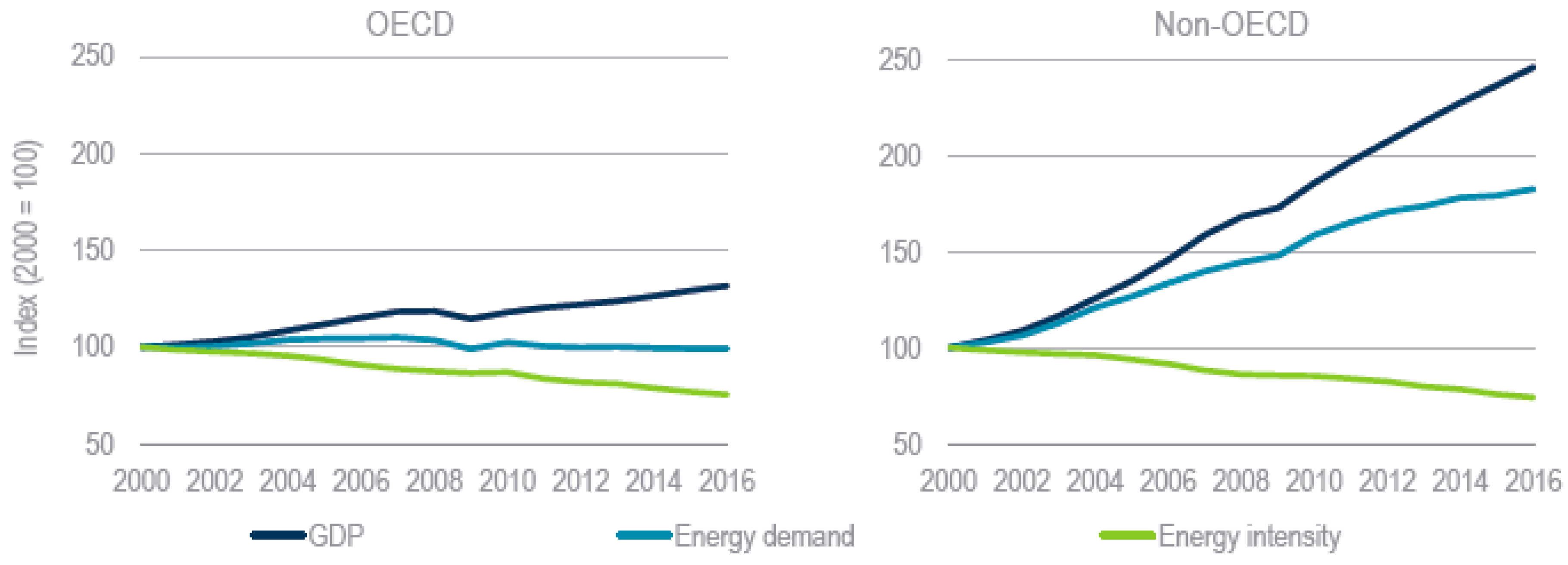
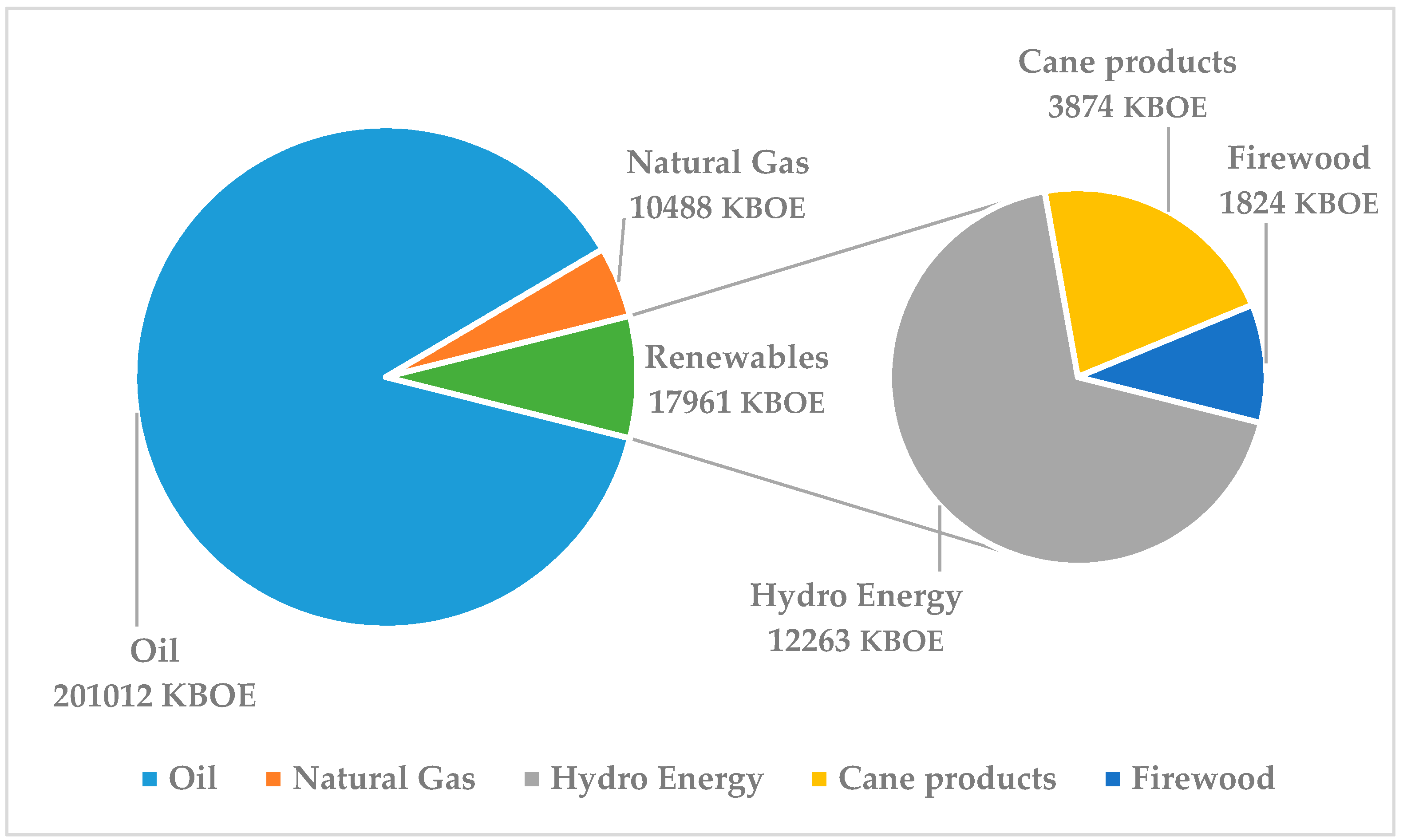
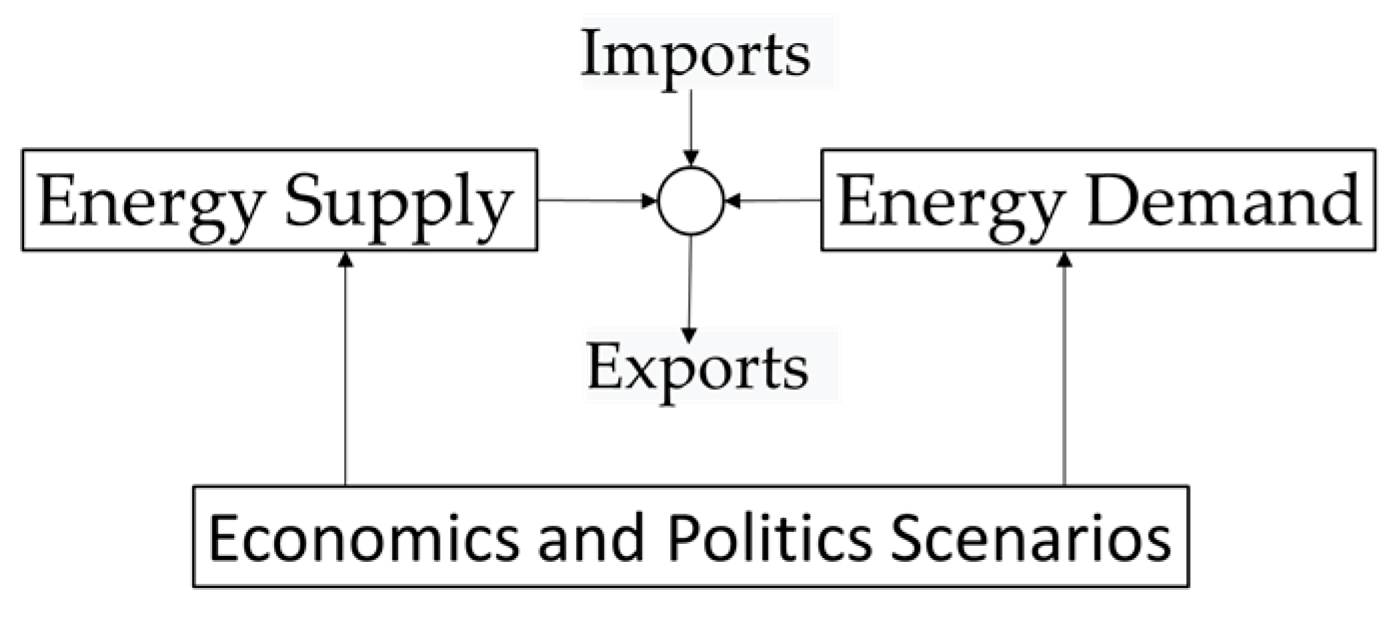
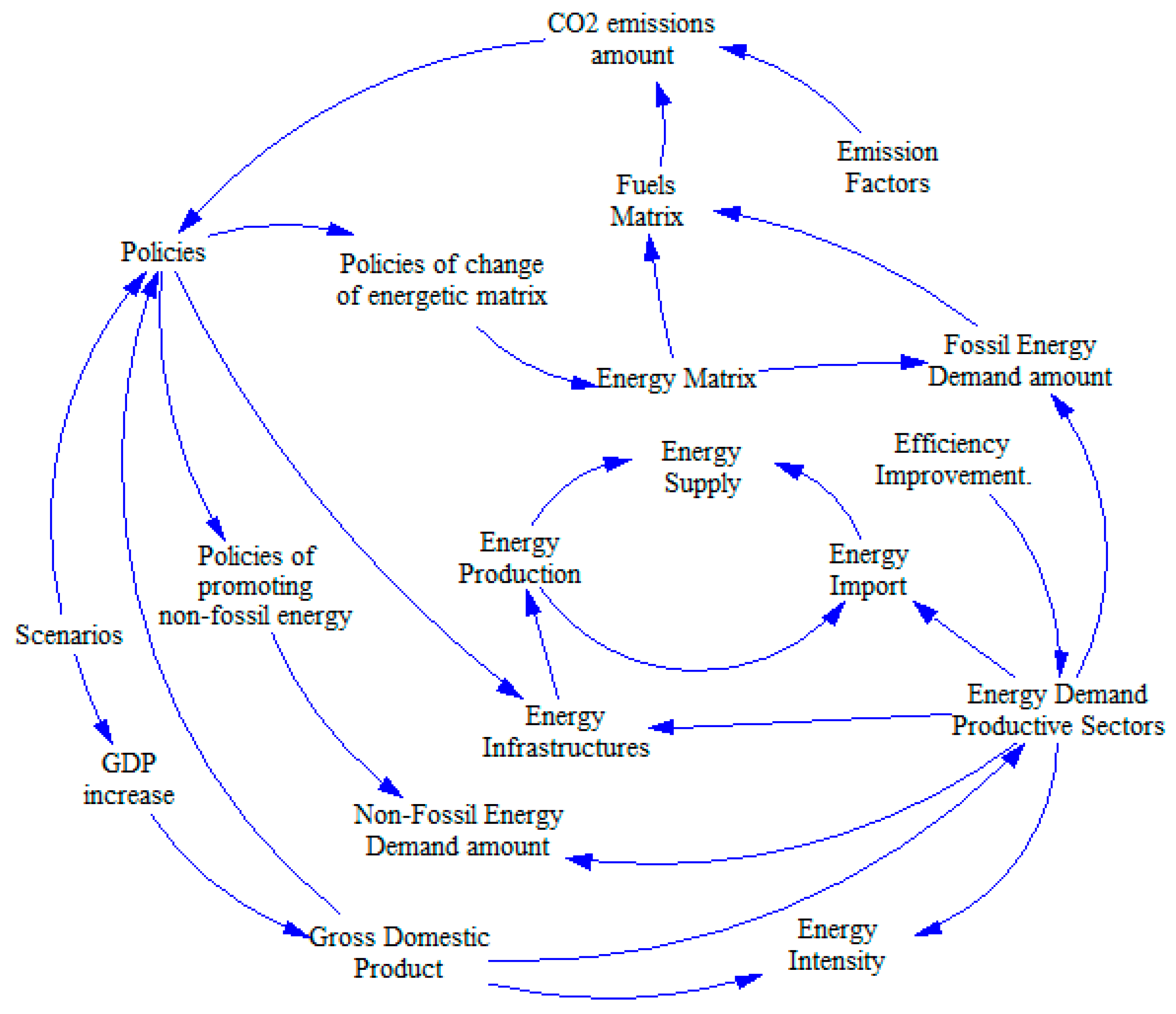
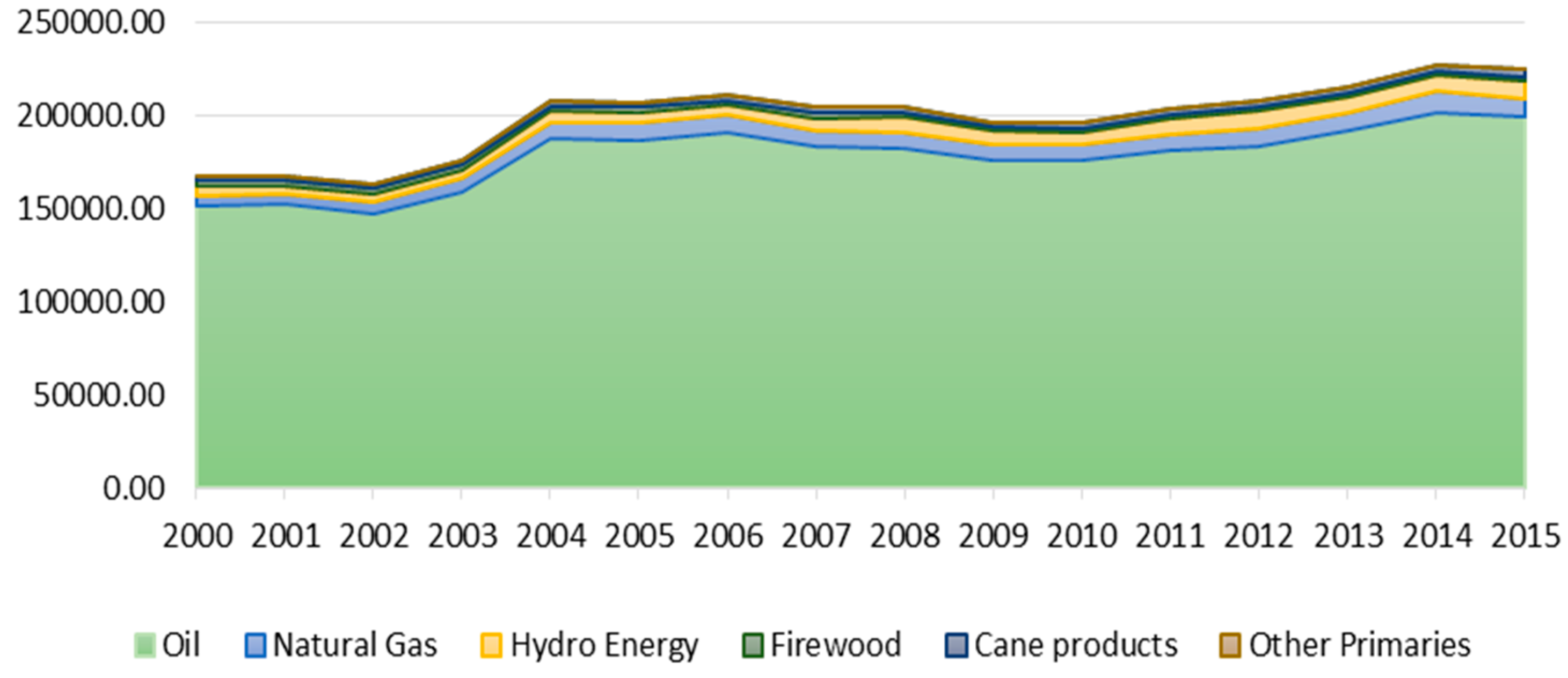
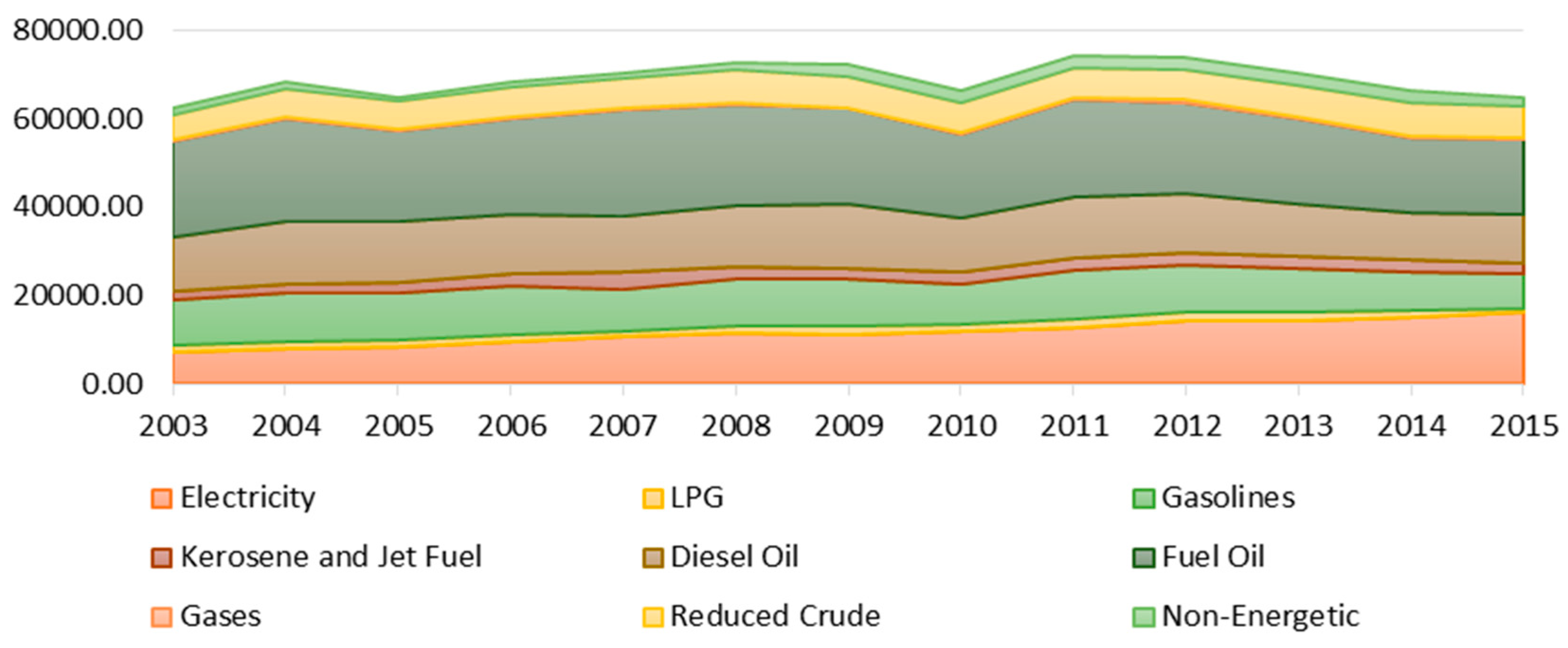
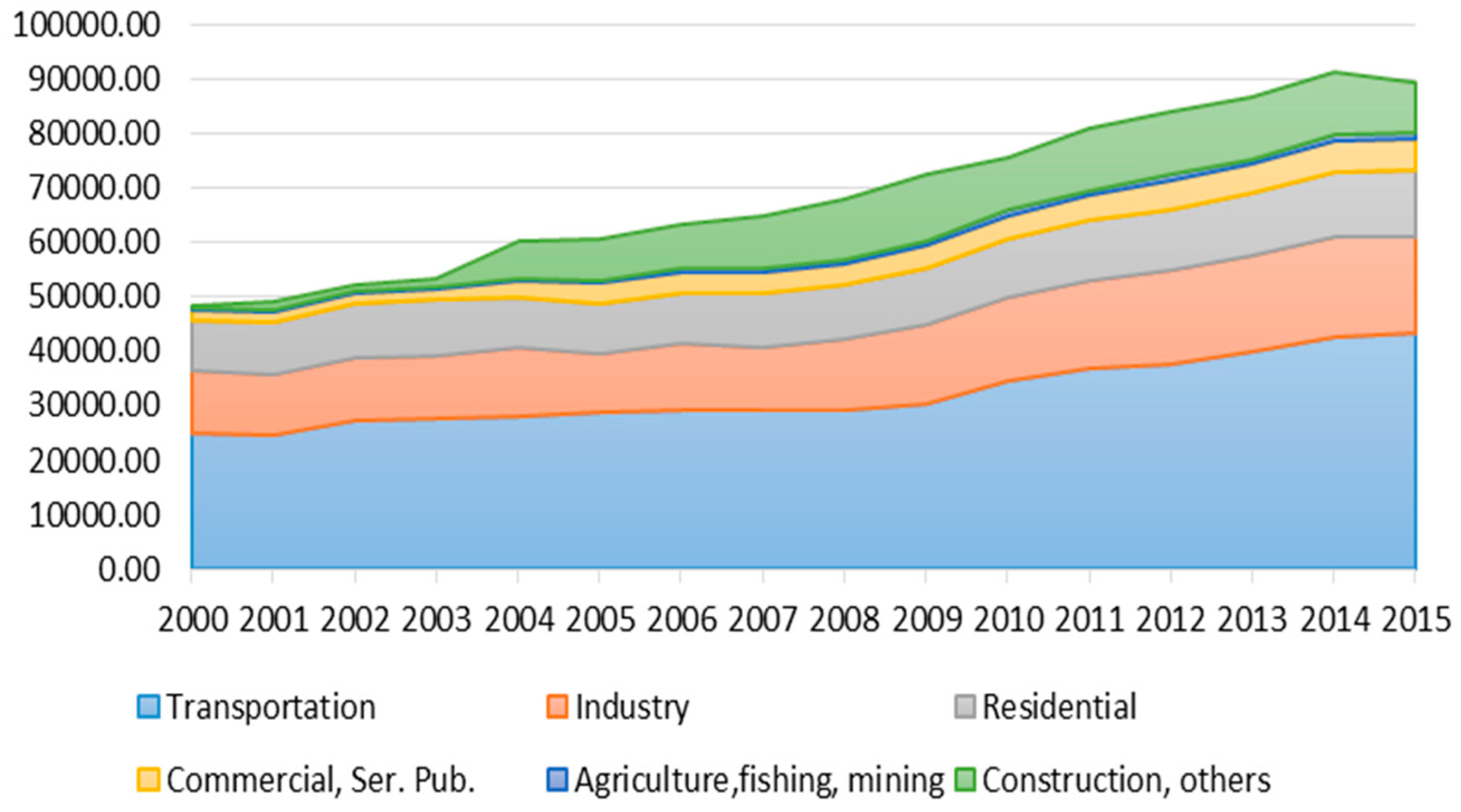
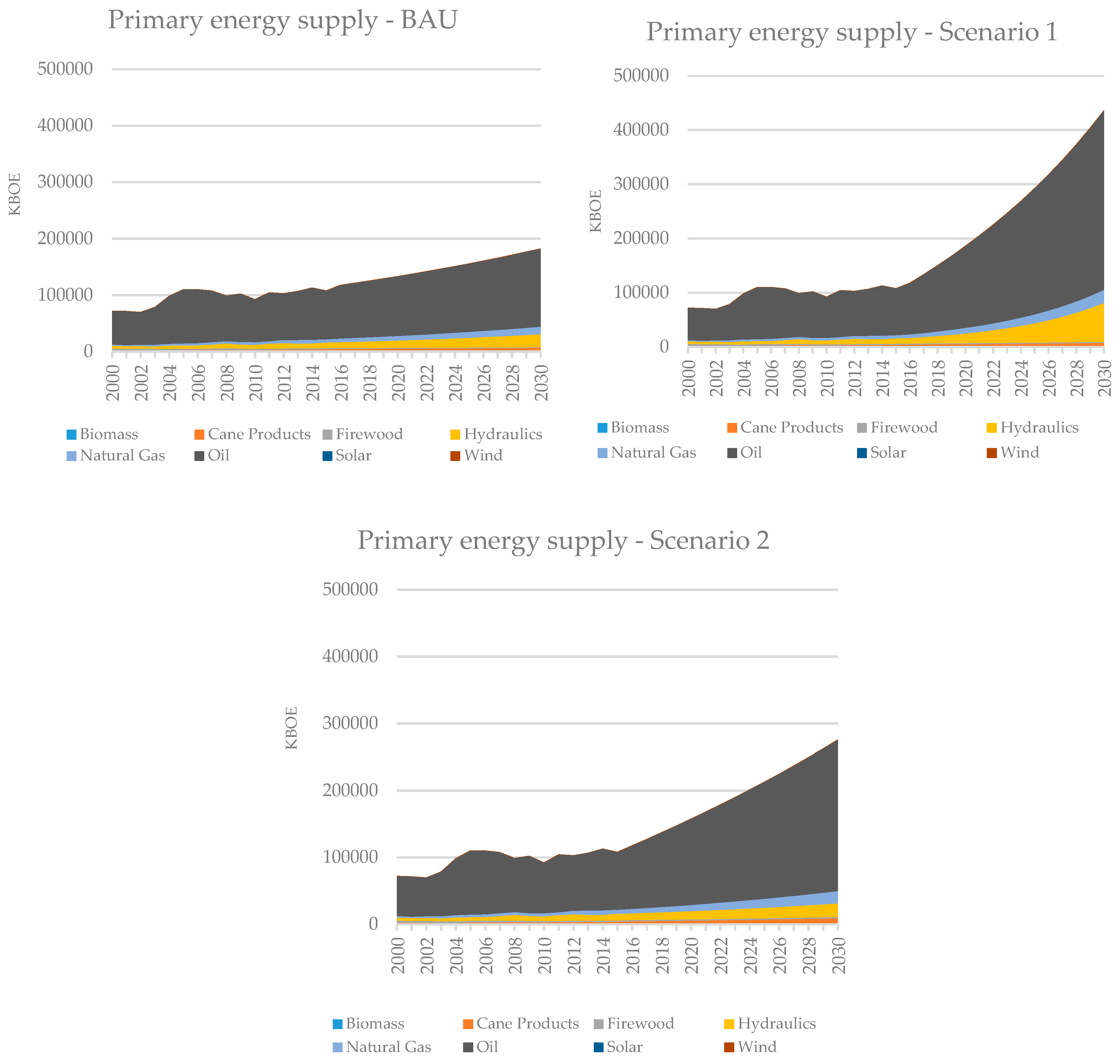
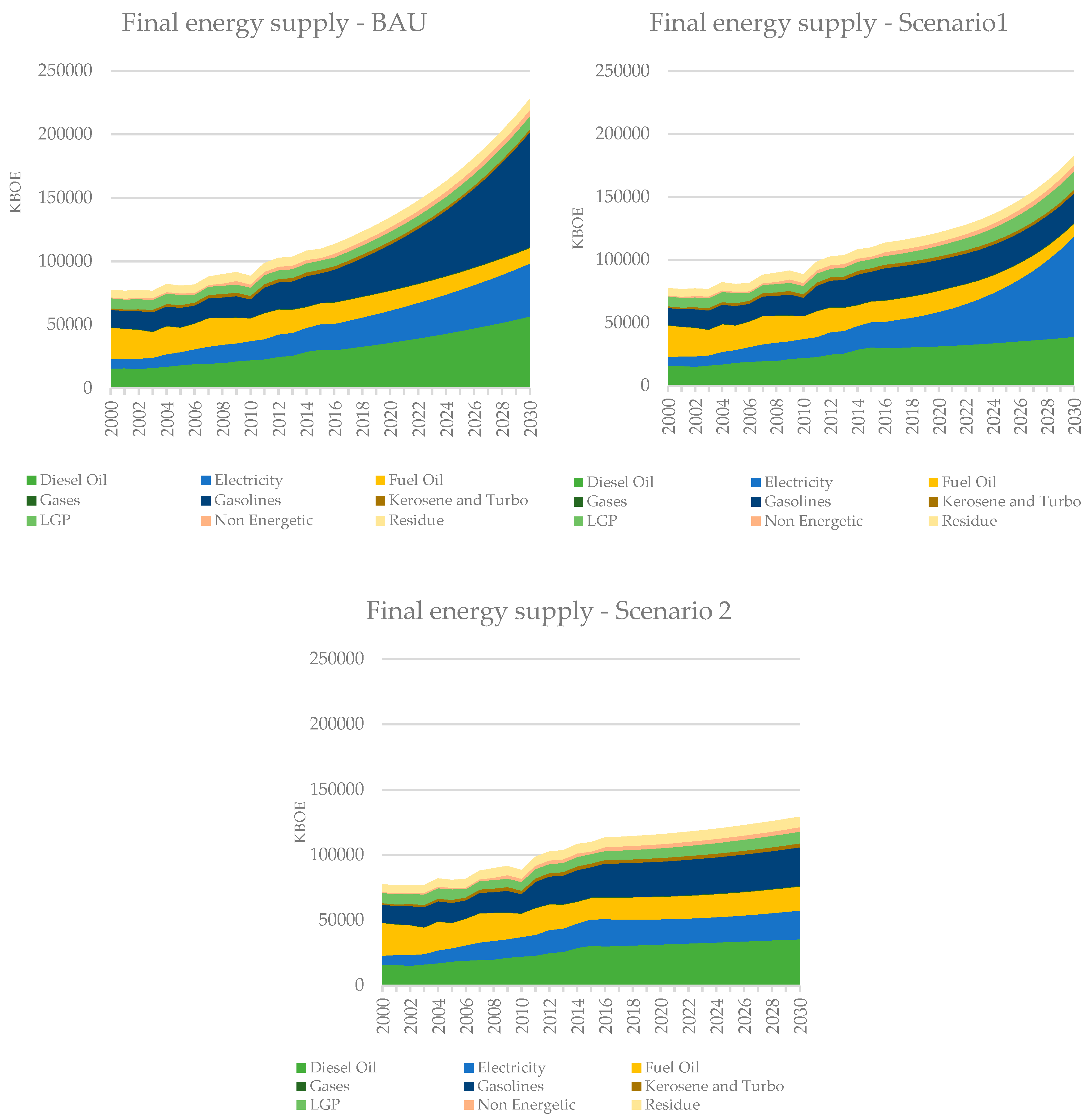
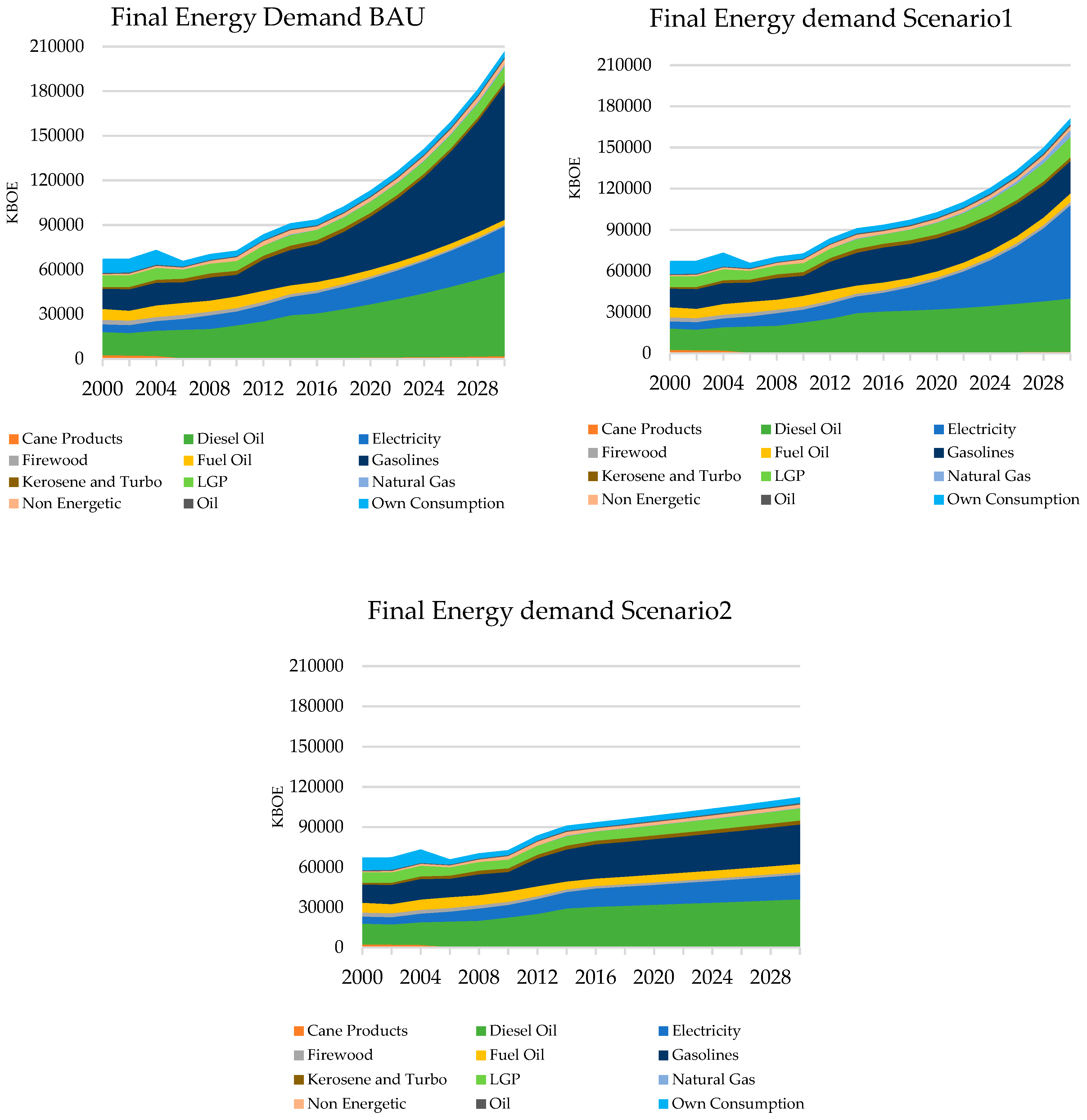
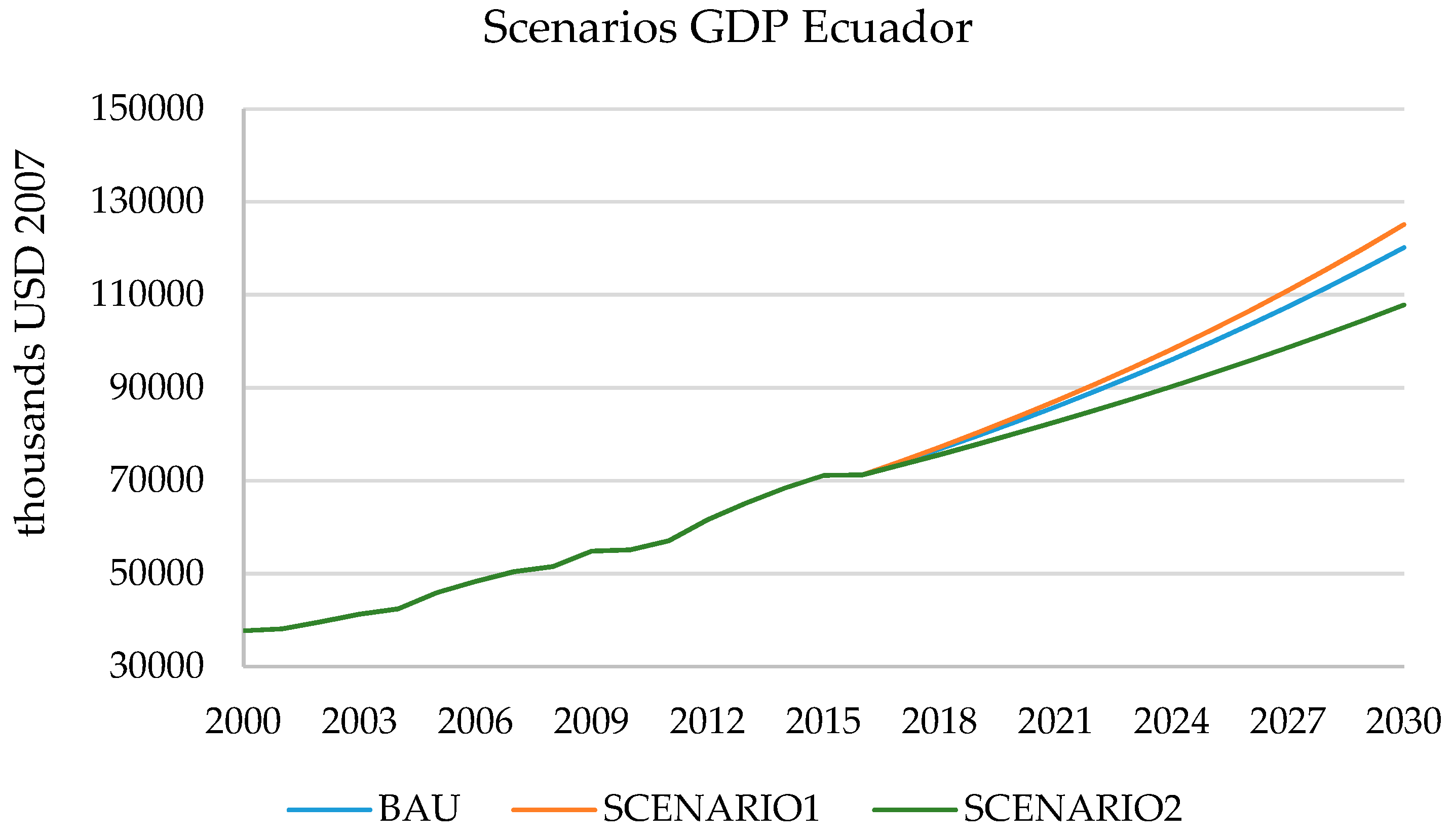
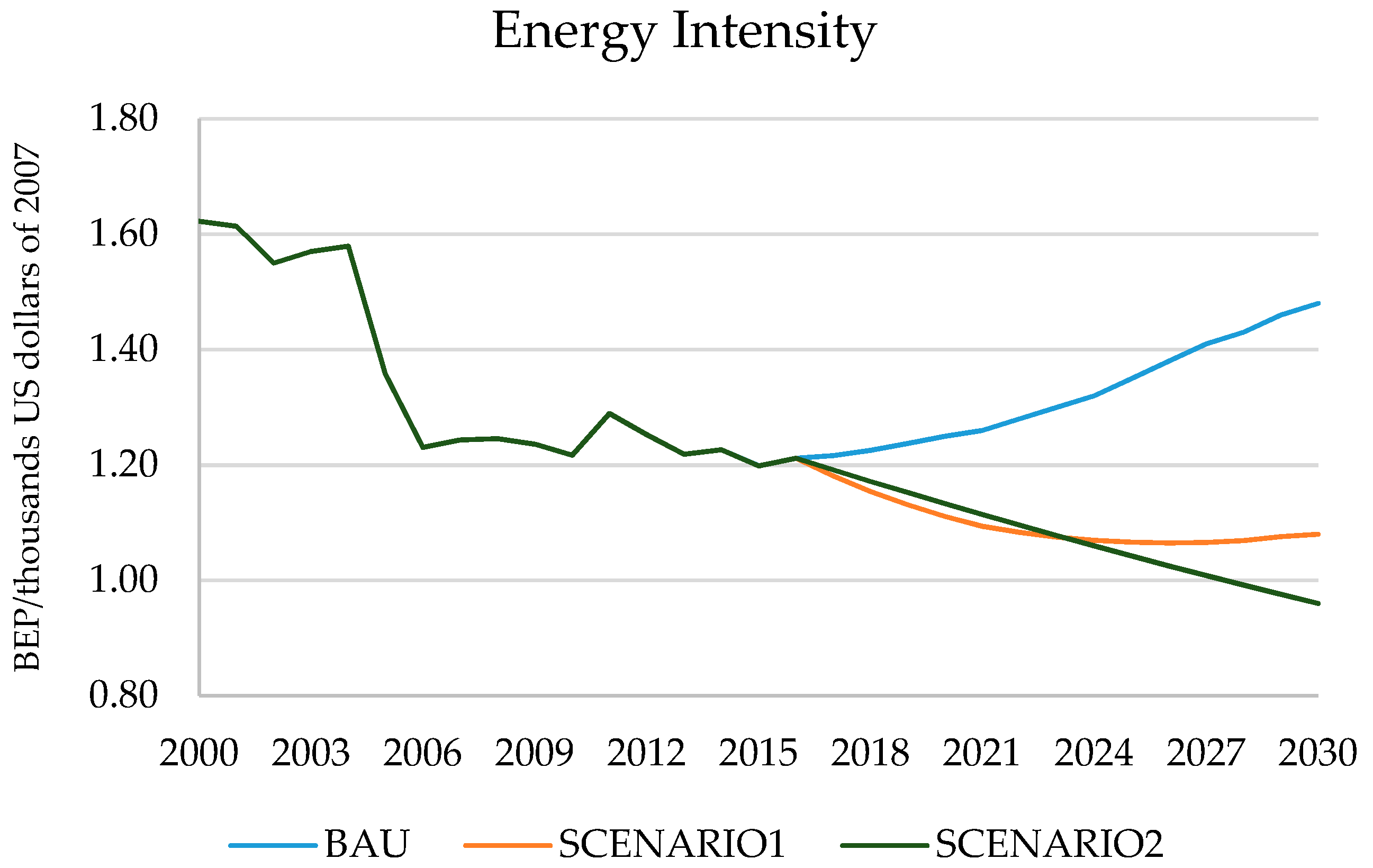
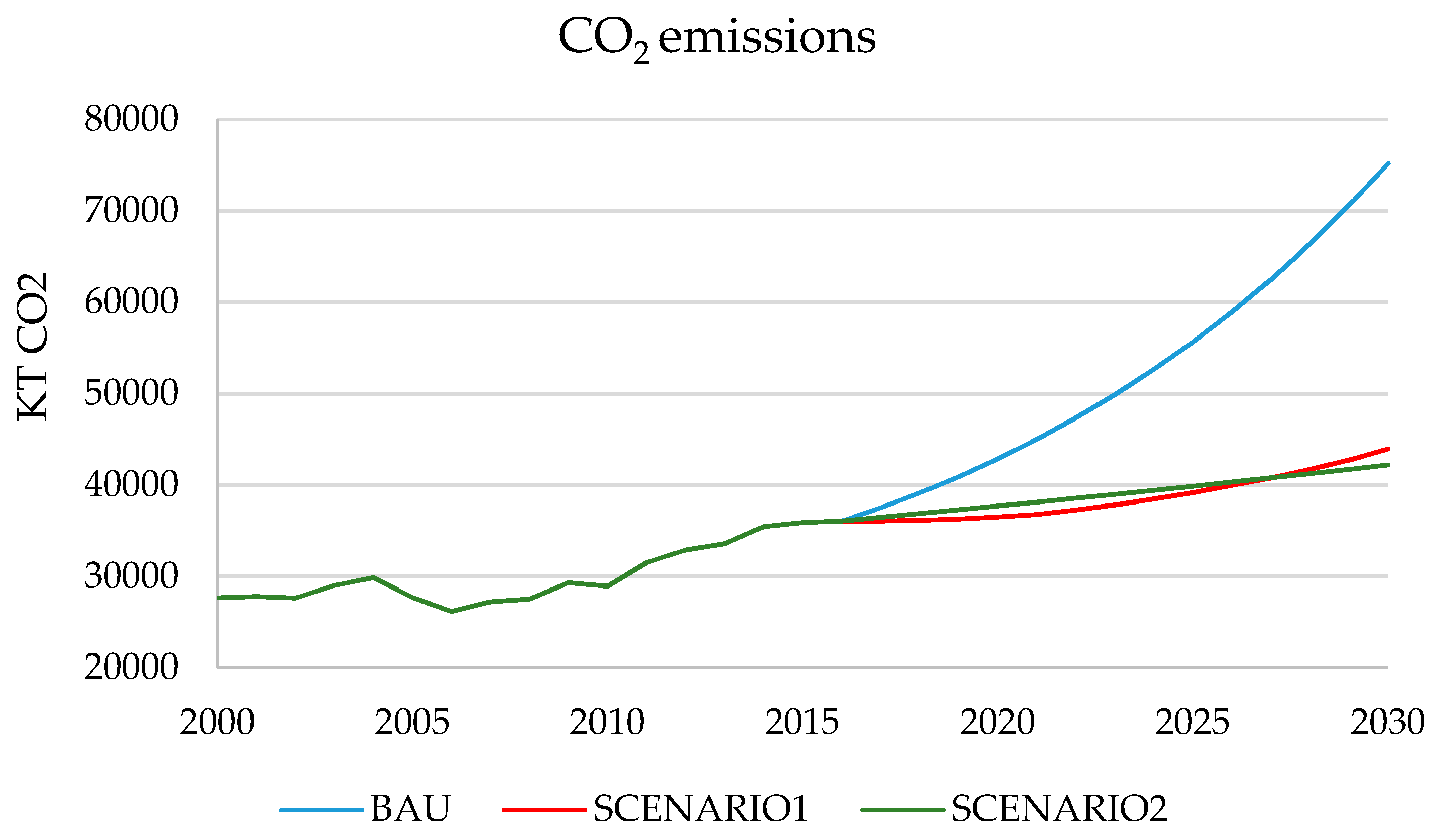
| Conversion Factors CO2 Emission | (Kg CO2/BOE) | (Kg CO2/TJ) |
|---|---|---|
| Petroleum | 448.54 | 73,300 |
| Natural gas | 343.29 | 56,100 |
| Firewood | 685.36 | 112,000 |
| Cane Products | 433.24 | 70,800 |
| Electricity | − | − |
| Petroleum liquid gas | 386.13 | 63,100 |
| Gasolines | 424.06 | 69,300 |
| Kerosene and Turbo | 439.97 | 71,900 |
| Diesel | 453.44 | 74,100 |
| Fuel Oil | 473.63 | 77,400 |
| Solar / Wind | − | − |
| Asphalts and lubricants | 448.54 | 73,300 |
| GDP | Energy Demand | Energy Intensity | CO2 Emissions | |||||||||
|---|---|---|---|---|---|---|---|---|---|---|---|---|
| Year | Real Data (milesUSD2007) | Simulated (milesUSD2007) | MAPE (%) | Real Data (KBOE) | Simulated (KBOE) | MAPE (%) | Real Data (BOE/Thousands of USD 2007) | Simulated (BOE/Thousands of USD 2007) | MAPE (%) | Real Data (MegatonsCO2) | Simulated (MegatonsCO2) | MAPE (%) |
| 2000 | 37,726.4 | 37,726.4 | 0.0 | 60,202.5 | 63,775.6 | 0.1 | 1.6 | 1.6 | 0.0 | 27,477.0 | 27,658.8 | 0.0 |
| 2001 | 39,241.4 | 38,162.1 | 0.0 | 60,164.4 | 63,506.3 | 0.1 | 1.5 | 1.6 | 0.1 | 26,229.0 | 27,800.0 | 0.1 |
| 2002 | 40,849.0 | 39,773.0 | 0.0 | 60,122.5 | 63,198.1 | 0.1 | 1.5 | 1.5 | 0.0 | 25,480.0 | 27,642.7 | 0.1 |
| 2003 | 41,961.3 | 41,485.2 | 0.0 | 61,213.8 | 65,506.6 | 0.1 | 1.5 | 1.5 | 0.0 | 28,607.0 | 29,022.7 | 0.0 |
| 2004 | 45,406.7 | 42,670.0 | 0.1 | 63,329.1 | 66,579.8 | 0.1 | 1.5 | 1.5 | 0.0 | 28,709.0 | 29,856.4 | 0.0 |
| 2005 | 47,809.3 | 46,348.4 | 0.0 | 63,418.0 | 65,335.1 | 0.0 | 1.4 | 1.3 | 0.0 | 27,491.0 | 27,691.1 | 0.0 |
| 2006 | 49,914.6 | 48,922.8 | 0.0 | 59,648.0 | 62,570.7 | 0.0 | 1.3 | 1.3 | 0.1 | 26,540.0 | 26,168.1 | 0.0 |
| 2007 | 51,007.8 | 51,183.0 | 0.0 | 61,734.0 | 64,899.0 | 0.1 | 1.3 | 1.3 | 0.1 | 27,010.0 | 27,223.6 | 0.0 |
| 2008 | 54,250.4 | 52,360.0 | 0.0 | 64,515.0 | 66,877.2 | 0.0 | 1.3 | 1.2 | 0.1 | 27,500.0 | 27,537.8 | 0.0 |
| 2009 | 54,557.7 | 55,856.6 | 0.0 | 69,555.0 | 70,066.1 | 0.0 | 1.3 | 1.2 | 0.1 | 28,000.0 | 29,302.6 | 0.0 |
| 2010 | 56,168.9 | 56,190.9 | 0.0 | 69,718.0 | 69,081.3 | 0.0 | 1.3 | 1.2 | 0.1 | 30,100.0 | 28,917.2 | 0.0 |
| 2011 | 60,569.5 | 58,273.6 | 0.0 | 74,931.0 | 75,832.7 | 0.0 | 1.4 | 1.3 | 0.1 | 32,000.0 | 31,507.4 | 0.0 |
| 2012 | 64,106.0 | 63,089.0 | 0.0 | 77,789.0 | 79,499.1 | 0.0 | 1.3 | 1.2 | 0.1 | 34,000.0 | 32,906.5 | 0.0 |
| 2013 | 67,081.0 | 66,957.7 | 0.0 | 81,610.0 | 81,746.5 | 0.0 | 1.3 | 1.2 | 0.1 | 35,400.0 | 335,94.5 | 0.1 |
| 2014 | 69,632.0 | 70,437.8 | 0.0 | 86,048.0 | 86,519.7 | 0.0 | 1.4 | 1.2 | 0.1 | 36,800.0 | 35,464.2 | 0.0 |
| 2015 | 70,345.0 | 73,388.8 | 0.0 | 86,323.0 | 90,329.3 | 0.0 | 1.4 | 1.2 | 0.1 | 37,000.0 | 35,902.8 | 0.0 |
| 2.18 | 3.49 | 5.65 | 3.04 | |||||||||
© 2019 by the authors. Licensee MDPI, Basel, Switzerland. This article is an open access article distributed under the terms and conditions of the Creative Commons Attribution (CC BY) license (http://creativecommons.org/licenses/by/4.0/).
Share and Cite
Arroyo M., F.R.; Miguel, L.J. The Trends of the Energy Intensity and CO2 Emissions Related to Final Energy Consumption in Ecuador: Scenarios of National and Worldwide Strategies. Sustainability 2020, 12, 20. https://doi.org/10.3390/su12010020
Arroyo M. FR, Miguel LJ. The Trends of the Energy Intensity and CO2 Emissions Related to Final Energy Consumption in Ecuador: Scenarios of National and Worldwide Strategies. Sustainability. 2020; 12(1):20. https://doi.org/10.3390/su12010020
Chicago/Turabian StyleArroyo M., Flavio R., and Luis J. Miguel. 2020. "The Trends of the Energy Intensity and CO2 Emissions Related to Final Energy Consumption in Ecuador: Scenarios of National and Worldwide Strategies" Sustainability 12, no. 1: 20. https://doi.org/10.3390/su12010020
APA StyleArroyo M., F. R., & Miguel, L. J. (2020). The Trends of the Energy Intensity and CO2 Emissions Related to Final Energy Consumption in Ecuador: Scenarios of National and Worldwide Strategies. Sustainability, 12(1), 20. https://doi.org/10.3390/su12010020





